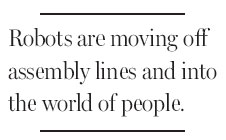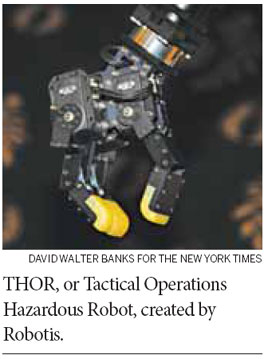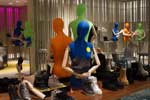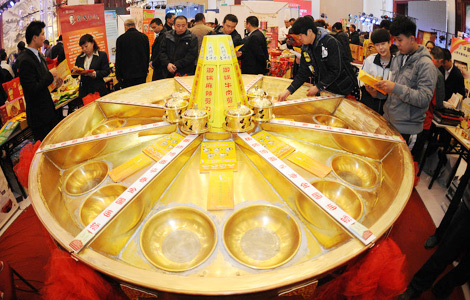Robots like us
Updated: 2013-11-24 13:52
By John Markoff (China Daily/Agencies)
|
|||||||||||
A shift toward machines with human form
On a recent morning Natanel Dukan walked into the Paris offices of the French robot maker Aldebaran and noticed one of the company's humanoid NAO robots sitting on a chair. Mr. Dukan, an electrical engineer, could not resist. He kissed the robot on the cheek. In response the NAO tilted its head, touched his cheek and let out an audible smack.
It is certainly a very French application for a robot, but the intimate gesture by the $16,000, half-meter robot, now being used in academic research labs and robotic soccer leagues, also reflects a significant shift.
Until recently, most robots were carefully separated from humans. They have largely been used in factories to perform repetitive tasks that required speed, precision and force. That generation of robots is dangerous, and they have been confined for the protection of workers.
|
RoboThespian, above left, is designed for human interaction; NAO, a French robot; and Schunk's Five-Finger Hand. Photographs by David Walter Banks for The New York Times |
Now, robots are beginning to move around in the world.
They are also beginning to imitate - and look like - humans. And they are beginning to perform tasks as humans do, too.
"This is the wave that's happening in robotics right now," said Charlie Kemp, an associate professor in biomedical engineering at the Georgia Institute of Technology in Atlanta. "Things are not the same when you're interacting with people. That's where we want robots to be; it's where we see there are huge opportunities for robots; and there are very distinct requirements from what led to the classic industrial robot." 
Many of the new generation of robots are operated from a distance, but are increasingly doing tasks independent of direct human control.For instance, Romeo, a 1.5-meter humanoid robot, will soon be introduced by Aldebaran as a "big brother" to the kissing NAO robot. Created with the assistance of $13.8 million from the French government, the robot is being programmed to care for older people and assist in the home.
To provide useful assistance, it will have to do more than the repetitive work already being performed by commercial robots in factories, hospitals and other settings. Moreover, the new robots are designed not just to replace but to collaborate with humans.
The idea that robots will be partners of humans, rather than stand-ins or servants, is driving research at universities and industrial laboratories. Today's robot designers believe that their creations will become therapists, caregivers, guides and security guards, and will ultimately perform virtually any form of human labor. (Robots that can think on their own have yet to arrive.)

The key to this advance is the new robots'
form. Their humanlike appearance does more than satisfy science-fiction fantasies. Roboticists say they are choosing the human form for both social and technical reasons. Robots that operate indoors, in particular, must be able to navigate a world full of handles, switches, levers and doors that have been designed for humans.
Roboticists also point out that humans have an affinity for their own shape, easing transitions and making collaboration more natural. Creating robots in humanoid form also simplifies training and partnerships in the workplace, and increases their potential in new applications like caregiving.
At Carnegie Mellon University in Pittsburgh, Pennsylvania, Manuela M. Veloso, a professor of computer science, has developed a series of robots she calls CoBots to perform tasks like delivering mail, guiding visitors to appointments and fetching coffee. She calls it "symbiotic autonomy," since the robots also rely on humans.
For example, because they don't have arms, they can't operate elevators, so they have been programmed to wait and ask for human assistance. If they get lost, they stop, call up a map of the building on their computer screens, interrupt a passing human and say, "I am lost, can you tell me where I am?"

"The robotics community calls the idea cheating," Dr. Veloso said, "but it's not. It's the secret to real autonomy."
Rapid improvements in computer vision, processing power and storage, low-cost sensors, as well as new algorithms that allow robots to move in cluttered environments, are making these new uses possible and in the process changing the nature of robotics.
And so on factory floors around the world, a new breed of robot is being manufactured by companies like Rethink Robotics of Boston, which makes a humanoid robot for simple automation tasks, and Universal Robots of Odense, Denmark, which makes a dual robot-arm system designed for more traditional applications, but without cages.
Rethink Robotics recently released a video of its robot, Baxter, making a cup of coffee. The company said the humanoid robot, with tong-like hands and a computer-screen face, was trained to carry out a variety of preprogrammed tasks in several hours.
In Dr. Kemp's Healthcare Robotics lab at Georgia Tech, a 1.5-meter robot named Cody, which is able to sense forces on its arms and has a base that allows it to move gracefully, is being used as a dance partner for both experienced human dancers and patients in physical therapy.
"This is a way that robots can be used for fun, interactive exercise in rehabilitation," he said. "We can also use it as a tool to understand whole body physical interaction between people and robots."
The New York Times
Related Stories
Shanghai opens interactive robot exhibition 2013-10-12 10:46
Robot classes set students up for future careers 2013-08-15 10:44
Fast food restaurants recruit robots in kitchen 2013-02-06 17:44
Robots are not just for boys 2012-12-25 11:26
Robots create human emotions 2012-08-17 15:12
Today's Top News
UN talks agree on major principles for climate pact
China maps out air defense ID zone
Nokia has 'phab' plan for Chinese mobile market
Newtown investigation report to be released
Li expected to sign big deals
Air defense zone announced
Chinese rescuers reach Philippines
Conditions set for future CE
Hot Topics
Lunar probe , China growth forecasts, Emission rules get tougher, China seen through 'colored lens', International board,
Editor's Picks

|

|

|

|

|

|






